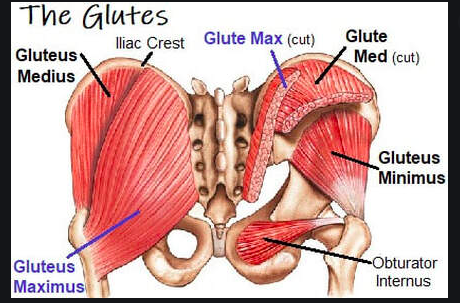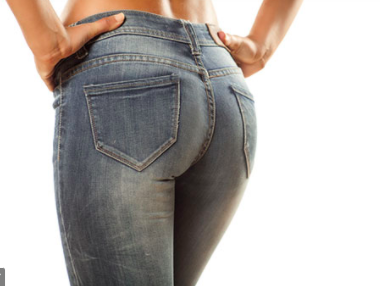Are you a butt squeezer? Has squeezing the seat and turning your legs out or “wrapping your thighs” worked to give the desired effect of a lifted, sculpted, strong derriere?
No?
Yes, I know!
Clenching your butt cheeks is not the same as engaging the gluteal muscles. It won’t do you any favors but bring your ischial tuberosities or Sitz bones closer together and tense up the muscles in your buns and lower back making you tuck under. Not to mention making your cellulite show though. Gripping your seat won’t strengthen, lift or get the glutes to work efficiently. And externally rotating your legs in every exercise is creating an imbalance in your body.

I haven’t squeezed my butt in exercise in years and I now work mostly in a parallel position, yet at 50 years old, my backside is stronger and more sculpted than ever. I’ve focused on the muscles in my my hips and legs working properly and evenly so I can walk up stairs, run and jump into old age. I want this for my clients as well.
Having a more lifted, round look is a nice side effect but what I’m really interested in, is function. I work my hips, legs and butt muscles in a balanced way, not just one way, like turning out in every exercise, (which is common in Pilates but not balanced or good for us! ) We must also work in parallel much of the time.

The human body is amazing. Our muscles perform the actions they’re designed to do, if we let them. We have all these muscles in our pelvis that are meant to work together. The Gluteus Maximus, Minimus and Medius, the deep external rotators (the Piriformis, Obturators, Gemellus and Quadratus Femoris) as well as the adductors (inner thigh muscles) and hip flexors.
The Gluteus Maximus is the large, powerful muscle that helps propel us forward. Its job is hip extension and external rotation (when your leg is behind you and turned out).
The Gluteus Medius and Minimus are smaller muscles higher up on the butt. They’re responsible for abduction (when your leg goes to the side) and hip stabilization.
Then we have the adductors (inner thigh muscles) and hip flexors. Everyone knows the Psoas because it’s the largest one and it attaches to the lumbar spine and top of the femur, but it’s not the only one. There are five! For healthy, strong hips and backs we must engage all five (Illiacus, Sartorius, Rectus Femoris and Pecteneus) But how? Read on.

If we always work in the typical “Pilates Stance,” (heels together and legs turned out in external rotation, like a V), and always “wrapping the thighs” or turning out, we are actually creating imbalances in the body. Not what we want! It’s appropriate to use that stance in some exercises, but certainly not all.
Now that I work more in parallel, hugging the midline, which works the deep external rotators (not the same thing as externally rotating your legs) and always engaging my lower abdominals and lifting up in my spine, my body has changed for the better. That Joseph Pilates quote “Feel the difference in 10 sessions. See the difference in 20 sessions. Have a whole new body in 30” feels truer now.
You’re like, “Molly, what the heck are these Gemeli Sartorius Obturators?! What are you talking about??”
Okay, let me simplify through movement. Do these 3 things:
1) Hug the midline in every exercise. If your legs are together, squeeze your heels together and work towards parallel with as little external rotation as possible. For those of you with knock knees, you’ll have to bend and turn out a little. Still hug the midline in one leg exercises like leg circles by pressing toward the center line (pretend you’re squeezing a ball). Do it in Side Kicks and Teaser and Swimming. Everywhere.
2) Use the back of your legs way more! In The Roll-up, press your heels firmly into the mat to engage the muscles in the back of your legs. Do this is in the one Leg Circles for the leg on the mat. Press your heels down in Spine Stretch Forward, Saw and Neck Pull.
3) Engage your lower abdominals (Transverse Abdominis and Internal Obliques) and lift up in your lower back in every single exercise. If this doesn’t make sense yet, come to one of my classes and I promise you’ll feel it!
Easy, right? Not exactly. It’s simple, yet very hard work to do these three things in every exercise. But I’m telling you, if you do, you’ll get stronger and a more balanced, pain-free body. Money back guaranteed.
Then go deeper with these exercises to really get into that po-po. Check out this quick video here.
1) Side Kicks. Kick your leg front and back keeping your hip bones stacked and pelvis stable. Remember always engage your lower abs. Tip: When the leg goes front, reach your Sitz bones back. When the leg goes back, reach your pubic bone forward. Those actions with lower abdominal engagement will keep your pelvis stable.
2) Up/Down Side Kicks in parallel. Try it. You’ll be strengthening the Gluteus Medius. Try it in all three positions. We all need this!
3) Shoulder Bridge. Do this hip-socket width apart (narrower than you think) and don’t squeeze your seat for Pete’s sake! Simply press into your heels and peel your pelvis and spine off the mat. You’re in hip extension here, so your glutes are doing their jobs – no squeezing necessary!
4) All 4’s – take a ball and place it between hamstrings and calf. Keeping a level pelvis lift the leg up and down. You don’t have to squeeze the buns – the whole back of your leg is working. You feel it?
5) Take it onto the Reformer for Pelvic Lift. Here press down with your heels and extend your legs. Resist the springs on the way in. Note: I’m in external rotation here, working the Glute Max and hamstrings.
6) Squats. I love squats in many positions and they are part of Pilates. You see Joseph Pilates doing squats all over the place with springs on the Cadillac, on the Reformer, and on the mat. If done in the proper alignment (track your knees over your 2nd and 3rd toes when you bend. Keep your spine’s natural curves – no tucking! And PULL IN YOUR LOWER ABDOMINALS AND LIFT YOUR LOWER BACK) Squats are soooo strengthening for your lower body.
Take some time and try this stuff. Let me know what you think! If you want to go deeper into this work, come take a class with me! Check out my and group class schedule HERE

